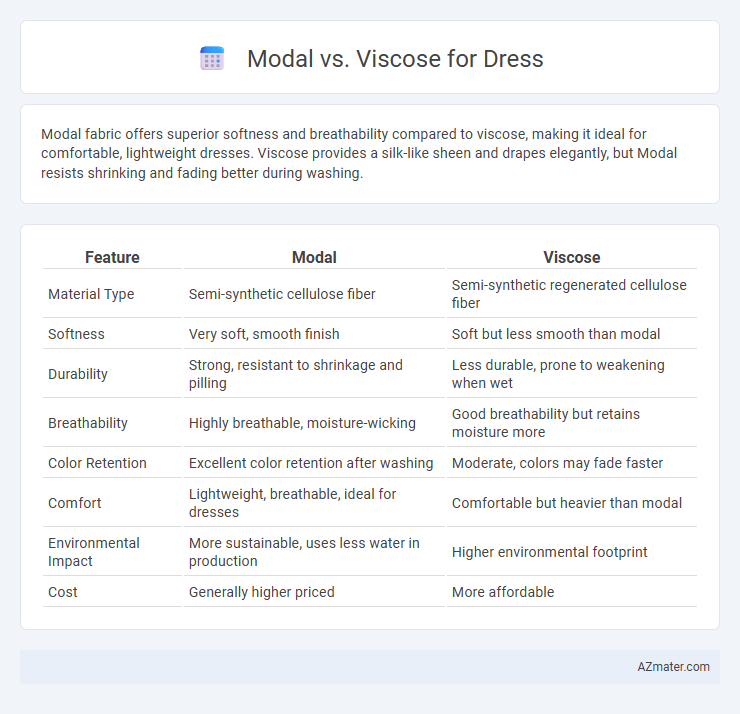Modal fabric offers superior softness and breathability compared to viscose, making it ideal for comfortable, lightweight dresses. Viscose provides a silk-like sheen and drapes elegantly, but Modal resists shrinking and fading better during washing.
Table of Comparison
| Feature | Modal | Viscose |
|---|---|---|
| Material Type | Semi-synthetic cellulose fiber | Semi-synthetic regenerated cellulose fiber |
| Softness | Very soft, smooth finish | Soft but less smooth than modal |
| Durability | Strong, resistant to shrinkage and pilling | Less durable, prone to weakening when wet |
| Breathability | Highly breathable, moisture-wicking | Good breathability but retains moisture more |
| Color Retention | Excellent color retention after washing | Moderate, colors may fade faster |
| Comfort | Lightweight, breathable, ideal for dresses | Comfortable but heavier than modal |
| Environmental Impact | More sustainable, uses less water in production | Higher environmental footprint |
| Cost | Generally higher priced | More affordable |
Introduction: Understanding Modal and Viscose
Modal and viscose are both semi-synthetic fibers derived from cellulose, commonly used in dress fabrics for their softness and breathability. Modal is known for its higher durability and resistance to shrinking compared to viscose, making it ideal for long-lasting garments. Viscose offers a silk-like feel and excellent drape, but it requires more delicate care due to its tendency to wrinkle and weaken when wet.
Fabric Origins: How Modal and Viscose Are Made
Modal is a semi-synthetic fabric derived from beech tree pulp, produced through a more advanced chemical process that enhances fiber strength and softness. Viscose, often called rayon, originates from regenerated cellulose primarily sourced from wood pulp, treated chemically to create a versatile textile with a silk-like appearance. Both fabrics involve transforming natural cellulose into fibers, but Modal's production emphasizes eco-friendlier methods and higher durability compared to traditional viscose manufacturing.
Sustainability: Environmental Impact Comparison
Modal, derived from beech tree pulp, is considered more sustainable than viscose due to its closed-loop production process that recycles water and chemicals, minimizing environmental pollution. Viscose production often involves toxic chemicals like carbon disulfide, which harm ecosystems and contribute to higher carbon emissions. Both fibers are biodegradable, but modal's eco-friendly manufacturing and less intensive resource usage make it a preferred choice for sustainable dress fabrics.
Texture and Feel: Comfort Factors for Dresses
Modal fabric offers a smooth, silky texture that feels exceptionally soft against the skin, enhancing comfort in dresses through its breathable and moisture-wicking properties. Viscose, while also soft, has a slightly more textured and matte finish that provides a lightweight and breathable feel but may lack the same silky smoothness as modal. Both fabrics excel in comfort, yet modal's superior softness and durability contribute to a more luxurious tactile experience in dresswear.
Durability: Longevity of Modal vs Viscose Dresses
Modal dresses exhibit superior durability compared to viscose, maintaining fabric strength and color vibrancy through numerous washes, thanks to their semi-synthetic cellulose fiber composition derived from beech trees. Viscose dresses, while soft and breathable, tend to weaken and lose shape more quickly due to their regenerated cellulose fibers being less resilient under stress and moisture exposure. Choosing modal enhances the longevity of dresses, ensuring better resistance to pilling, shrinking, and wear over time.
Breathability and Moisture Management
Modal fabric offers excellent breathability due to its natural cellulose fibers, allowing air to circulate freely and keeping the wearer cool. Viscose also provides good breathability but tends to absorb moisture more rapidly, which can lead to a damp feel in humid conditions. For moisture management, Modal excels by wicking sweat away from the skin and drying quickly, making it ideal for active wear and warm climates.
Color Retention and Fade Resistance
Modal fabric exhibits superior color retention and fade resistance compared to viscose, maintaining vibrancy even after multiple washes. Its semi-synthetic cellulose fibers are treated to enhance color absorption, resulting in longer-lasting hues. Viscose tends to fade more quickly due to its less stable fiber structure, making modal a preferred choice for dresses requiring durable, rich colors.
Ease of Care: Washing and Maintenance Tips
Modal fabric offers excellent ease of care, as it is machine washable and resistant to shrinkage, making it ideal for everyday dresses. Viscose requires more delicate handling, often needing hand washing or dry cleaning to maintain its softness and prevent damage. For both fabrics, using cold water, gentle detergents, and avoiding high heat drying helps extend the life of the dress.
Cost Comparison: Modal vs Viscose Dresses
Modal dresses generally cost more than viscose dresses due to the more complex manufacturing process and higher quality of fibers used in modal fabric. Viscose, a type of rayon, is often less expensive because it is produced using a less intensive chemical process and is more widely available. When comparing costs, modal dresses usually offer greater durability and softness, which can justify the higher initial price compared to more affordable viscose options.
Which is Better for Dresses? Final Verdict
Modal offers superior softness and breathability, making it ideal for comfortable, everyday dresses, while viscose provides a silk-like appearance with excellent drape and vibrant color retention, perfect for more formal styles. Modal is more durable and resistant to shrinkage compared to viscose, which tends to wrinkle easily and requires delicate care. Choosing between modal and viscose depends on the desired balance of comfort, appearance, and maintenance, with modal generally preferred for casual wear and viscose favored for elegant, flowing dresses.

Infographic: Modal vs Viscose for Dress
 azmater.com
azmater.com